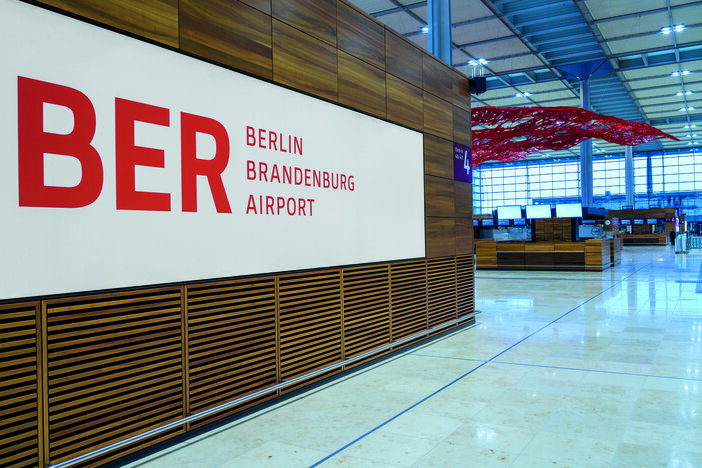On October 31, 2020, Berlin Brandenburg Airport (BER) officially opened its doors – more than 14 years after it broke ground in September 2006. The story of the airport’s development and construction, and its numerous scheduled opening dates, is a long and complicated one, littered with planning and management errors.
Back in March 2012, PTW visited BER ahead of the scheduled opening on June 3 that year (see One-off, March 2012 issue). At the time, the airport was carrying out final trials and hosting media tours to show the new hub to the world. Rainer Schwarz, CEO of BER from 2006 to 2013, told the media how it had been “a long journey with many challenges, but the BER project is on track and we are looking forward to the opening in June”.
The June 2012 opening never happened. In the weeks leading up to the planned opening date, concerns over fire safety arose, with claims that the smoke extraction system didn’t work. The airport was then refused its airport operating license. What followed was the unraveling of BER as more than 550,000 problems came to light, including questions around escalator sizes, cabling, ceiling designs and ticket counters. There were also issues with the management team and with construction, which saw Schwarz leave, new executives come and go, and further opening dates, including in 2014 and 2016, pushed back.
What was already one of the biggest projects in aviation history grew even larger. The original cost of the airport was around €2.4bn (US$2.8bn), but costs spiraled to approximately €5.9bn (US$7bn). New management was brought in, including new CEO Prof. Dr.-Ing. Engelbert Lütke Daldrup in March 2017, with one clear aim: to open the airport. The team decided that they wouldn’t set another opening date until they knew for sure that the airport could open on time. In late 2019, the October 31, 2020 opening date was set and work began on making sure everything would go as smoothly as possible.
Patrick Muller, the airport’s chief operating officer, says, “I joined the BER team two-and-a-half years ago. The first question I faced when I joined was, ‘How are you going to convince staff that this time BER is actually going to open?’ I said, ‘We can’t. We just need to show them.’ And that’s what we did. We set a realistic date and stuck to it.”
So, on October 31, BER just opened. “There was no party, no fanfare,” says Muller. “After all these years, we didn’t want to celebrate. We just wanted to show the world we could do it. Over the past few years the team has worked hard to ensure all processes and procedures at the airport are working well. There has been a great spirit of teamwork and I am proud to be a part of the project.”
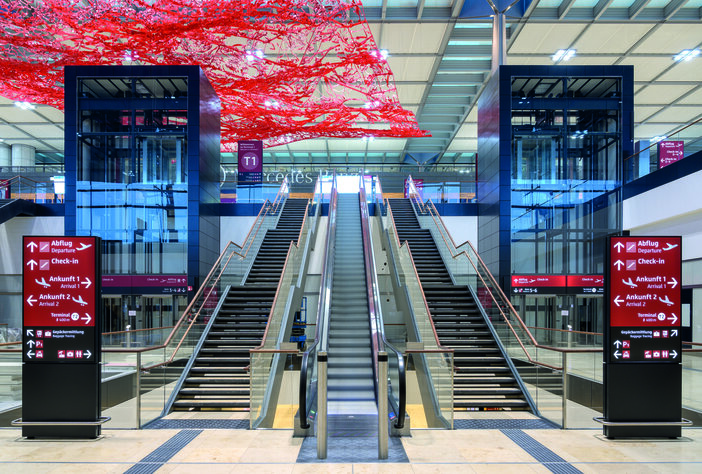
The 2020 opening
According to Muller, opening a new international airport during a global pandemic has been challenging, but delaying the opening date again was not on the cards. “We never thought about postponing the opening again,” he reveals. “Berlin needed this facility desperately – the city needed a modern airport for the capital of Germany.”
BER has now replaced Tegel and Schönefeld airports – both of which were extremely congested, outdated and tired. Tegel closed its doors on November 8; Schönefeld’s operations have now been modernized and integrated with BER and will become BER Terminal 5. BER has two other terminals in addition to T5, and two runways. “We also have T1, which is the famous delayed terminal, and T2, which is highly automated with self-service solutions and geared toward low-cost operations,” Muller explains. “And we have two runways: the northern runway of BER is the southern runway of the old Schönefeld Airport, and there
is a newly built southern runway.
“T2 is not online yet as passenger traffic is so low because of the pandemic,” says Muller. “We are saving about €500,000 (US$593,000) a month if we keep it closed. We will continue to observe how traffic develops and bring it online when needed. On a normal winter season day we would handle 70,000 to 90,000 passengers, but currently we are handling less than 10,000 passengers a day.”
According to Muller, BER has an ultimate passenger capacity of approximately 43 million passengers across its three terminals. “Then we will have to look into the development of further facilities, but that is far from being the case right now. Now, we are focusing on getting back to 2019 levels – when this will be, we don’t know,” he adds.
One of BER’s unique selling points, notes Muller, is its railway station, which is directly under T1 and connects the airport to Berlin Central Station in just 25 minutes. The station has been built to handle up to 125,000 passengers per day across three platforms and six tracks. The station at the former Schönefeld Airport – now BER T5 – also remains operational. “If I am not mistaken, BER is one of the only airports to have a train station underneath the terminal,” Muller says. “When passengers arrive by train, they just take the elevator and then they find themselves in the check-in hall. This train station is one of the reasons the development of BER took so long. We had to manage two sets of regulations: the regulations of the construction authority for the region and those of the railway authorities. Bringing these two together was a major challenge.
“We also have a network of other public transport connections that go into the region. Ultimately, in a few years, we hope that German railway company Deutsche Bahn will be ready with a new high-speed track connecting us to Dresden in the South and Hamburg in the North,” he adds. Currently there is only one fast connection between Dresden and Rostock.
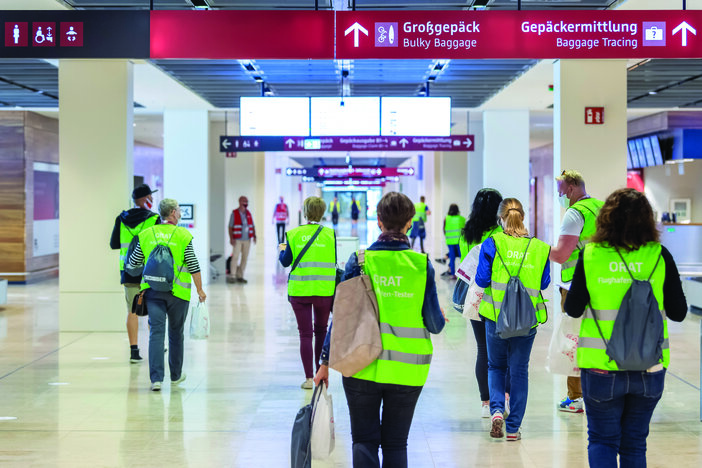
Operational readiness
Prior to opening, BER carried out various operational readiness and airport transfer trials and tests. The opening was set to take place in three steps, but Covid-19 put another wrench in the works. “The first step was to consolidate the operation of easyJet in the new T1; the second step was to bring in all the airlines that would have used T2. Then the last step was to bring the rest of the airlines from Tegel to T1,” Muller explains. “This obviously didn’t go quite to plan because of Covid-19.
“The concept and strategy worked out but on a much lower level,” he continues. “We had a soft opening, but obviously the following steps where passenger numbers and aircraft movements ramped up hasn’t happened yet.”
In April 2020, BER started trials at the airport, split into three phases. The first was a basic scenario in which only internal staff and stakeholders participated and no trial passengers were involved. In June, the second trial phase saw integrated trials with trial passengers. “These were strongly influenced by Covid-19 and health and safety measures,” explains Muller. “We had to reduce the number of trial passengers from about 800-1,000 to 400 maximum. These trials were mainly about simulating what would happen in extreme situations such as a full evacuation of the terminal or a complete baggage handling system breakdown. Then in August we started the final stage of the trials, which saw standard procedures and processes tested. This final stage gave reassurance to staff that the basic processes, such as check-in, boarding and security screening, all worked well.”
Covid-19 also influenced how staff were trained and familiarized with the airport and its systems. “We had developed an extensive training program for all of our stakeholders, where staff would work on the apron or in the terminal to get up to speed on how everything works,” explains Muller. “But we had to turn these into online courses rather than on-site courses. Within a two-week period we transferred all of the written and paper-based content to an IT-based system. We also used drones to make short films on access roads, parking, check-in, layout, security, etc, and built those in to the online courses.”
According to Muller, the online courses were effective, but staff still needed some on-site training. “We decided to reduce groups and enhance social distancing and bring people inside the terminal so they could actually walk the routes they needed to take and use the systems first hand,” he explains. “We trained about 150 ‘super-users’ on-site and they have trained the remainder of the staff.”
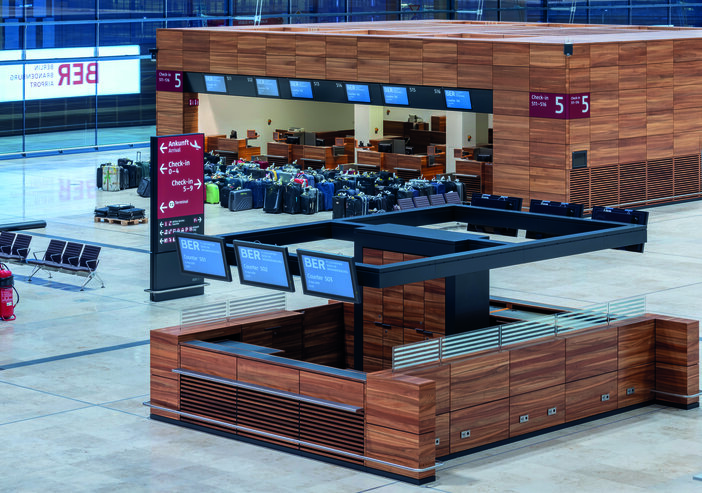
Connections at BER
The main purpose of BER is to enhance Germany as a global destination and give the country the modern airport it has needed for the past few decades. BER hopes to become a leading airport in Europe, boasting efficient interconnectivity and intermodality. “Connectivity is a major selling point for the airport,” explains Muller. “We have the train station connecting us to central Berlin and further afield, and we are now working on improving our international airline connections.
“We already benefit from an open-sky agreement between Europe and the US, and before Covid-19 a number of North American airlines had flights set up for the winter season at BER. We hope these will return once the airlines can fly again. We are now working with the Department of Transport in Germany to develop traffic rights for flights to Asia and the Middle East. This discussion isn’t proving to be very successful at the moment but we hope that the new BER will change this. We now have all the requirements, facilities, processes and procedures that international airlines require, in a modern hub.”
According to Muller, BER is also working on a new product to try to attract more airlines: “We are seeing more and more passengers set up their own transfer connections, so they book two flights and self-connect through BER, which is now easily feasible. We have engaged with five airlines that are interested in this, and we are about to launch a product that will facilitate baggage transfer at BER if you have two different flights connected. We are working with international platforms that can facilitate the transfer of luggage from one flight to another. Passengers will just need to print out their baggage tags to the final destination at the first point of check-in. We hope that this will generate additional traffic and attract additional airlines.”
Another of BER’s benefits for passengers is short walking distances. The T1 pier is 700m long and passengers always depart or arrive at the center of this. “This means that passengers only have to walk about 350m to reach baggage reclaim or their gate,” Muller continues. “This is one of the things passengers have been most impressed by so far. They are out of the airport in about 10 minutes if they only have hand luggage, and around 20 minutes if they have to pick up hold baggage.”
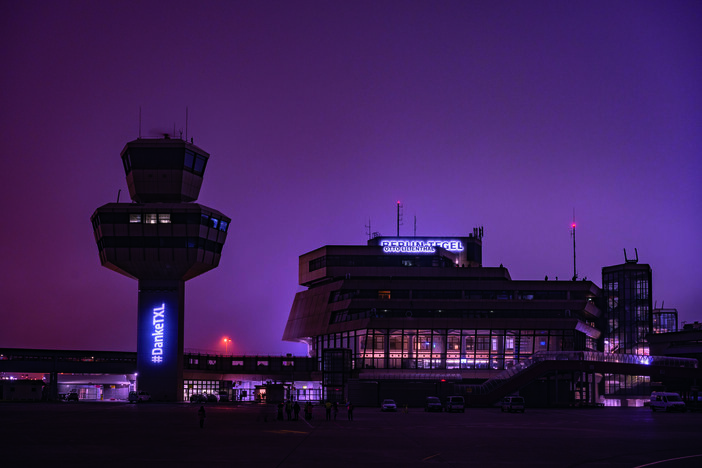
Generating revenue
If there is one good thing to come out of the fact that BER took so long to open, it is that the airport has become a tourist destination in itself. People travel from all over the country to come and see for themselves what the airport is like. According to Muller, this has generated a little extra revenue for BER during what is an extremely tough time in the aviation sector.
He explains, “Our visitor platform here at BER is inundated with thousands of curious people, especially on weekends, coming to see the airport. Entrance is still free. We are having to manage this carefully due to Covid-19 and often we have more people than space. The feedback we are getting from these visitors is that everybody likes the airport, which is great for us. The visitors are also using our landside facilities, including shopping, food and beverage and other outlets, while they are here, which is generating additional revenue for the airport. We are therefore trying to promote the airport as a center of attraction so that this limited revenue continues.
“We have also created a new Covid-19 testing center in T1, which is opposite the arrivals hall. This is attracting a lot of visitors. For €59 [US$71], passengers can get a test and receive the results within 24 hours.”
Generating non-aeronautical revenue is important for any airport right now, as many flights remain grounded. But for BER it is somewhat more important as it tries to recover from construction and opening delays that meant the project ran significantly over budget. According to Muller, the efforts put into opening BER after all these years will be worth it. “We truly believe that we now have the aviation facilities that the capital deserves, and can offer everything international airlines would expect from a capital airport,” he says. “It is my personal belief that in all the Skytrax ratings you will see coming up in the next few years, BER will be one of the Top 10 in Europe, if not worldwide.”
Read about how Dornier Consulting helped prepare BER for opening here.


